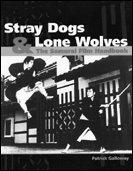Stray Dogs & Lone Wolves: The Samurai Film Handbook
by Tom Mes
Patrick Galloway's Stray Dogs & Lone Wolves: The Samurai Film Handbook functions as a kind of entry-level stage to the advanced course that is Alain Silver's ever-pertinent standard work The Samurai Film. presents itself as a guidebook and reference for fans and newcomers of the genre, covering 51 films, ranging from such acknowledged classics as Seven Samurai, Yojimbo, the Samurai trilogy and Sword of Doom, to established cult items like the Zatoichi series, Hanzo the Razor, and Lone Wolf and Cub. In between, Galloway gives ample space to lesser-known titles like Kenji Misumi's breathtaking Destiny's Son, the straight-faced Shinsengumi chronicle Band of Assassins, and the self-consciously epic Heaven and Earth, as well as to films on the outer fringes of the genre like the Yokai Monsters films, the Daimajin series, and the unforgettable Kwaidan. All of these are treated with the same enthusiasm by the author, who turns in well-researched and easygoing reviews.
A book of this kind is actually a lot trickier to pull off than it seems. Guidebooks about genres come with a built-in risk, a Catch-22 almost: being truly exhaustive and complete is usually an unrealistic (and, one could argue, pointless) option, and so the author has to limit himself to a selection based on either subjective criteria or on what is available to him. Either way, the fans will always complain that some of their favourites haven't been included.
Galloway has come up with one way of getting around this problem and setting clear parameters for himself and his readers: all the films included are available in some form with English subtitles. If any of the films under discussion tickle the reader's fancy, then he or she will know that they can get hold of them and also, thanks to the hints and release info provided by the author, how. Very handy indeed.
This approach has one drawback, though: it doesn't cover any new ground. Galloway treats roughly the same period as Silver does, i.e. the post-war years until the present day, beginning with the movie that started it all for Western fans: Kurosawa's Rashomon (and continuing all the way up to Yoji Yamada's Oscar-nominated Twilight Samurai). There is no information on the early years of the genre, and founding fathers like Daisuke Ito and Masahiro Makino receive no mention, despite the fact that they remained active well into the 1970s. This isn't necessarily criticism of Galloway, though. Anything pre-war is notoriously difficult to see - if even still extant. The author has simply chosen his parameters and follows them through quite well.
What does let the book down a bit, though, is the ease with which Galloway needlessly resorts to some of the less wholesome tendencies of populist fan writing. The back cover explains that one of his motivations to write this book was that he was "tired of seeing his favorite film genre mistreated by most academics." Given the dearth of English-language writing, academic or otherwise, devoted specifically to the samurai film, one wonders whether Galloway doesn't tire a tad too quickly. Still, even granted his reservations with existing writing, his attempts to write an accessible alternative, regularly sees him veer toward the other extreme; reading Stray Dogs & Lone Wolves you occasionally feel like you're being treated as a twelve-year-old whose closest experience of a samurai film is Kill Bill and The Last Samurai. The ridiculing of other genres (he takes regular cheap shots at the kaiju eiga, but doesn't stop to realise that Akira Kurosawa's budget-inflating whims were only possible thanks to the box office success of the efforts of all those "sweaty guys in rubber suits" working at the same studio), the railing against "cinema snobs", "academics" and "culture vultures", and the use of childish lingo like "loosey-goosey" - these are all misplaced and unnecessary, and merely tarnish what the author sets out to do. Galloway's strengths as a writer could easily have carried this book on their own, so why he felt the need to compromise his abilities and resort to the facile demonising and the underestimating of his readers is a bit of mystery.
Regardless of this, Galloway's guidebook will come as a valuable resource to many, particularly those new to the genre, and is guaranteed to start you off on a quest for great swordfight flicks. There are some nice visuals here too, with plenty of stills and poster artwork. The promo shots of the main players, in and out of samurai garb, are a particularly nice touch and include some unforgettable poses - check out Shintaro Katsu at his lounge lizard best in a white suit and bow tie.
Combined, Stray Dogs & Lone Wolves and Alain Silver's The Samurai Film form a worthy tribute to one of the great genres in world cinema history. Between them they contain more than enough for fans of the genre and those intrigued by the recent wave of Western tributes to chew on. But the full story of samurai cinema still remains to be told.
